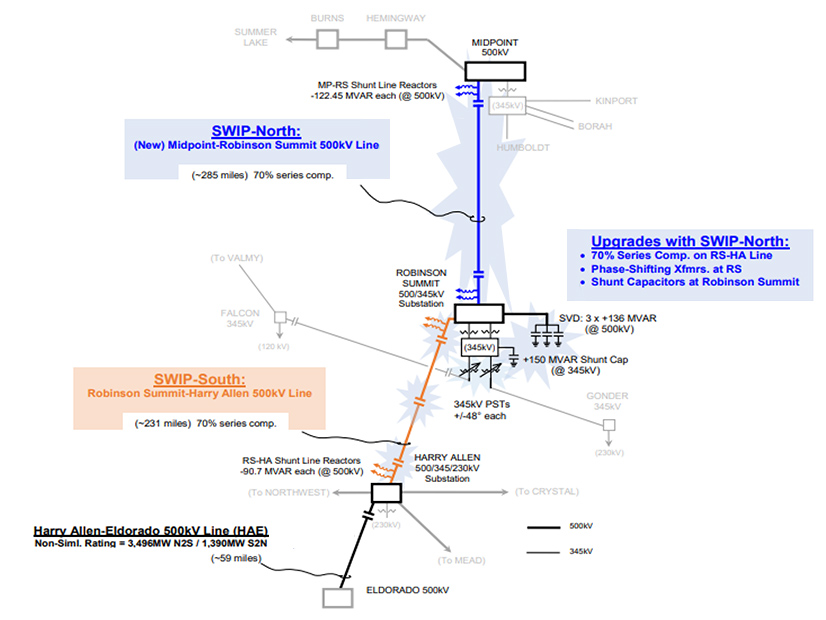
The CAISO Board of Governors on Oct. 4 unanimously approved changes to the Southwest Intertie Project-North (SWIP-N), a 285-mile, 500-kV line in Nevada that would enable access to Idaho wind resources, despite opposition from Gem State residents.
In April, the Department of Energy signed a facilitation agreement to provide $33.1 million to fund Idaho’s potential 22.831% share of the project to expedite the process. CAISO had asked the board to approve two motions: to allow the DOE funding, and to approve project developer Great Basin Transmission’s application to become a participating transmission owner in the ISO.
The project would enable CAISO to meet the California Public Utilities Commission’s Integrated Resource Plan requirements, which call for just over 1,000 MW of Idaho wind power in the 2024-2025 transmission planning cycle. According to transmission planners at the ISO, SWIP-N is the only known transmission project that would provide California load-serving entities with Idaho wind by 2027.
While SWIP-N was conditionally approved by the board in December 2023, moving to the construction phase still relied on the approval of the two motions.
“Unlike a project directly assigned to an incumbent transmission owner under the Transmission Control Agreement, this did not move the project straight to execution,” Neil Millar, vice president of infrastructure and operations planning at CAISO, said at the board’s meeting.
Deb Le Vine, executive director of infrastructure contracts and management at CAISO, presented details on the status of the project, as well as the two motions. The project was initially approved under four conditions: that Idaho Power file and receive approval for the project with the Idaho Public Utilities Commission by Sept. 30; that the California PUC reaffirm the need for Idaho wind in its 2024-2025 transmission planning process portfolio; that Great Basin declare its intent to become a PTO by July 1; and that FERC accept Great Basin’s proposed tariff and transmission revenue requirement rate structure.
Idaho Power has not yet filed with the Idaho PUC, meaning that FERC has not yet approved Great Basin’s tariff. The other two conditions were met.
“It’s critical to enable Idaho wind to reach California, consistent with the CPUC system plan,” Le Vine said.
Opposition from Idaho Residents
While SWIP-N isn’t tied to any specific generators in Idaho, some residents opposing the Lava Ridge Wind Power project and others in the region expressed concern about SWIP-N.
Dan Sakura, a fourth-generation Japanese American whose ancestors were interned at the Minidoka War Relocation Center in Idaho — a National Historic Site — said the area is now located in a “dense transmission network” because of its proximity to a railroad. Sakura, along with the Seattle-based Minidoka Pilgrimage Planning Committee, has been fighting LS Power since 2009 when it sought to build the SWIP-N line over the site. The organization is also fighting the Lava Ridge Wind Project, which it believes to be associated with SWIP-N.
Sakura asked the board to delay its decision until its meeting in December to allow for more time to “get a better analysis of the legal, regulatory, policy and electoral risks associated with wind energy from Idaho.”
Another Idaho resident, Dean Diamond, a farmer whose property borders the Minidoka site, echoed Sakura’s concerns.
“There is a lot of strong local opposition to the SWIP line and to the wind projects. I think that it poses a really significant risk that the wind projects most likely aren’t going to be built,” Diamond said.
“We’re not aware of that high opposition, just an attempt from those against the wind projects to link SWIP-N to that,” responded Mark Milburn, senior vice president of LS Power. “I think it’s also important to address that the commenters thus far haven’t acknowledged that in [the Bureau of Land Management’s] preferred alternative for the final environmental impact statement for the Lava Wind Ridge Project, they significantly scaled back the project to address the concerns raised by different stakeholders in that process.”
Milburn noted that the project footprint was reduced by 50% and the number of turbines by 40%, along with a 10% reduction in turbine tip height.
Board Chair Jan Schori thanked the commenters for participating in a process that “can be quite challenging to understand.”
“We do appreciate the fact that you’re participating with us today and helping educate us,” Schori said.

